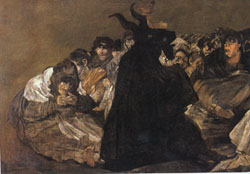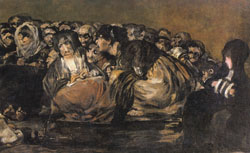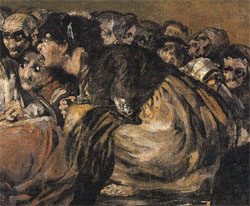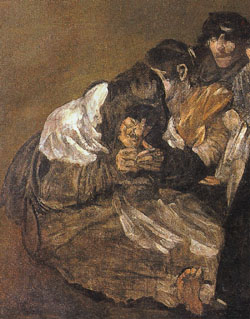The Black Paintings - Goat The term "black painting" was spawned by art historians wanting to classify the images in some nomencultural way. The individual titles, such as "goat" (shown above) were derived from what Goya's children called the images after Goya's death. "This
is probably the most well-known of the
black murals from the House of the Deaf.
An awestruck congregation gapes at the
silouhetted goat-devil. A white shrouded
figure* in the centre of the picture
appears to be issuing from a hole in
the ground, a grave or tomb. At the
extreme left of this extraordinary scene
of resurrection by sorcery sits the
demure figure of a young girl. She is
veiled and heavily draped in black,
her hands hidden in a muff. What is
her significance? Is she put there to
heighten the grotesqueness of the others,
or is she part of the ceremony, a seemingly
innocent victim like the adolescent
figures that are supposed to have a
strong affinity with poltergeists? Certainly
she heightens the horror of the scene." *The 'shrouded white figure' can clearly be seen to possess a human female face. Instead of a suggestion of a shrouded spectre, the figure would more likely suggest the habit of a renegade nun. The closeness to the goat also suggests a relationship between the two figures and also that the identity of the 'goat' is that of some ecclesiastical authority.
|
- - - - - - - - - - - - - - - - -
- - - - - - - - - - - - - - - - -
WEB SITE COPYRIGHT©1997-2006 ERIK E. WEEMS
IMAGES ARE COPYRIGHT TO THEIR RESPECTIVE OWNERS
http://www.eeweems.com/goya/goat.html
BIO | ARTWORK | BOOKS | RESOURCES FOR STUDENTS | LINKS | CONTACT | NEWS | STATS | F.A.Q.






